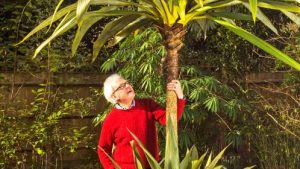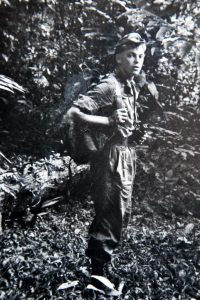Roy Lancaster has travelled the globe in search of exotic plants, many of which are now carefully catalogued in his Hampshire garden
 East, west, home’s best. In the morning, when Roy Lancaster opens his bedroom curtains at home in Chandler’s Ford, Hampshire, he looks out at a verdant scene, the story of a lifetime of collecting plants across the globe. “It is like opening the curtains of a theatre. It is a stage, and all these performers — an international cast of plants — they each have something to give me.”
East, west, home’s best. In the morning, when Roy Lancaster opens his bedroom curtains at home in Chandler’s Ford, Hampshire, he looks out at a verdant scene, the story of a lifetime of collecting plants across the globe. “It is like opening the curtains of a theatre. It is a stage, and all these performers — an international cast of plants — they each have something to give me.”
Being a dutiful husband to Sue, his wife of nearly 40 years, he trots downstairs to make the tea. “Then we sit in bed, drink our tea and plan the day. From our bed we can look out onto the tops of all those trees: the one to the right, the big magnolia in our garden, which fills the sky in April, is a Magnolia cylindrica, with huge flowers and red fruits and orange seeds that hang on threads. It’s wonderful.” He grew it from seed sent over from the Shanghai Botanical Garden; at more than 30ft, it is now a Champion tree — the largest of its kind in Britain.
Lancaster can also admire the top of the Chilean fire tree (Embothrium coccineum), Himalayan dogwood and weeping willow in his neighbour Dot’s garden. Beneath the window is a tea tree, Leptospermum grandifolium, with silvery grey leaves, and at the bottom of the garden is a Cornus ‘Porlock’, the first tree he planted in the garden, and also 30ft tall. It bears creamy white flowers in June, followed by an autumn crop of pendulous, strawberry-red fruits.
It is like opening the curtains of a theatre — an international cast of plants, each with something to give me
Lancaster will be 80 in December, a fact he would rather I hadn’t brought up when we meet at the red-brick, late-Victorian house where he and Sue have lived since 1982. “I don’t feel 80, I can tell you. I am very lucky in that instead of throwing away childish things and growing up, I only have to start talking about plants and my energy levels rise.” And indeed he talks with such unabashed enthusiasm for the various species in his garden, and the adventures he has had over his long life of looking for local flora in far-flung places such as China, New Zealand, Chile and Malaysia, he could still be the keen 14-year-old boy who paid 2s 6d of his pocket money to become a junior member of the Bolton Field Naturalists’ Society.

Collecting plants in the Malayan jungle, while on national service in 1958
Even after more than 50 years of living in the south, Lancaster retains his flattened Lancashire tones, which are instantly recognisable to gardeners of a certain age from his BBC broadcasts on Gardeners’ Question Time and Gardeners’ World. He is also a prolific plant explorer, lecturer and writer, and one of horticulture’s grandees — holder of both a Veitch Memorial Medal and the Victoria Medal of Honour, the Royal Horticultural Society’s highest honours, as well as both an OBE and a CBE for services to horticulture. President of various august horticultural societies, he has just written a book, the autobiography of his long relationship with plants.
Lancaster’s recall for these plants and where they come from would put an elephant to shame, yet there’s no trace of the impatience with those less knowledgable that you sometimes find with true plantsmen. Instead, he would rather share his passion than use it as a weapon of condescension, and for the past 20 years or so, he has been inviting groups of horticultural students to the garden for study days, with Sue feeding them tea and homemade cakes.

The sloping, south-facing back garden last summer, with the trunk of the 30ft Magnolia cylindrica grown from seed
It takes him back to his early years of interest in plants, when he was encouraged by mentors who were the age he is now; those seemingly innocent days when young boys and vicars could go out looking for wildflowers together without eyebrows being raised. Life has come full circle: “You see an interest developing and you want to fan the flames.” So, above all else, “if I was asked, ‘What is your greatest achievement in life?’, certainly in my job it has been encouraging young people”.
When the Lancasters bought their house, Roy had just left Sir Harold Hillier’s famous arboretum near Romsey (now called the Sir Harold Hillier Gardens and run by Hampshire county council), where he had worked initially in the nursery, then as its first curator for 10 years. Although he is always welcome back and remains a patron, “it was no longer mine; I had regarded it as my big garden”.
He needed somewhere to observe various plants he had collected, been given or just wanted to try out. The couple’s first home had been near Winchester prison, where he had gardened on chalk in a tiny space. To Lancaster, the soil wasn’t the problem many gardeners regard it as, but the garden was full and he was keen to try out the likes of rhododendrons, azaleas and camellias, which would turn their toes up in those alkaline conditions.
They hadn’t been looking in the area, but were told about the four-bedroom house, with a third of an acre of garden, and came to have a look.
“The house looked awful, inside especially,” Lancaster remembers, although he was more interested in what could be done outdoors. “There was nothing in the garden you could call an interesting ornamental plant, except for three Magnolia liliiflora ‘Nigra’. They stood out for their quality. There were some scabby apple trees that were dying and some soft fruit. Nothing else.”
As for the soil, the north-facing front garden, which is a large enough space for there to be lots of sun as well as shade nearer the house, is acidic sand over gravel and very well drained. “It’s the nearest you can get in cultivation to the Gobi desert in summer; water doesn’t hang around at all,” Lancaster says, with an excitement for such things that perhaps only a plantsman could display. It was the perfect place for the acid-loving plants he had been so missing, and would later become a home too for Mediterranean ones, which hate sitting with wet feet. The back of the house was south-facing on clay, with a bare wall on which to grow sun-loving climbers.
They decided to go for it. While Sue got on with improving the interiors, Roy was in charge of the garden. The magnolias are still there; however, he failed to follow the advice that he would give others — to wait a while in order to clear and prepare the space, then plan how you would populate it with some idea of an overall design. There were two truckloads of plants to accommodate, including many he had collected in China and Russia, and they had been sitting in a friend’s garden, waiting for a new home. They needed to get in the ground as soon as possible.
One idea he did have, though, was to divide the back garden into quarters, with two sections for Japanese and Chinese plants (“the mother of British gardens, where most of the species are found”), and another for miscellaneous species including those from the Himalayas. “The remaining quarter down at the bottom, I had that for several rows of seedlings, and I managed to grow vegetables.” However, the veg were too much like hard work, and he needed the ground for his precious ornamentals, so they were sacrificed.

In July last year, with the fine trunks of the snakebark maple, Acer ‘White Tigress’, taking pride of place among ferns and mahonias
So, too, was the original scheme. “Eventually the idea of having two quarters for China didn’t really work, because I had lots of other things I wanted to grow and there was no space,” he explains. So the populations have migrated somewhat into each other’s territory, but Lancaster records every move. “I have always kept a ledger recording every planting, dates, origin, who, when and where it has gone here. I’ve labelled every border and bed, so I know exactly where I have planted it, should I lose the label.” As he now has as many as 1,000 plants in the garden, it certainly helps.
The long-running garden show isn’t over yet, though: the couple are off to Malta this month, to look at the plant life there. Somehow one feels that a few new members will be joining the cast at Chandler’s Ford soon.
Treasures from the garden
Mahonia ‘Silverback’: A seedling raised and named by Lancaster from a plant collected in Sichuan, China, by a Japanese friend. It has a lovely silvery-white back to the leaves and a bold inflorescence of yellow flowers in late winter. It is totally hardy and makes a shrub up to 6ft. As yet unavailable commercially.
Grevillea victoriae: This evergreen shrub from southeast Australia grows happily by the front door on Lancaster’s sunny west- facing wall, producing striking clusters of salmon-red flowers even in February.
Acer ‘White Tigress’: The first one to be planted in a British garden, this snakebark maple now reaches 20ft. Lancaster was given it by a friend in Ohio. Named because it looks as though a tiger has sharpened its claws on the pale trunk.
Hypericum lancasteri: Collected by Lancaster in China and named by Dr Norman Robson, a world authority on hypericums. A small, mounded shrub that bears flowers with red-tinted sepals beneath golden petals in mid to late summer.
Veronica umbrosa ‘Georgia Blue’: Bronze-purple young leaves and Oxford blue flowers with a white eye in spring. Grown from a rooted sliver from the western Caucasus, where Lancaster spotted it flowering in the snow.
Eucomis vandermerwei: Bought at a plant sale, although it is native to South Africa. Lancaster grows his in a trough, where it seeds and divides to produce a large patch with strap-shaped, fleshy leaves and short crowded spikes of green and purple flowers in summer.




